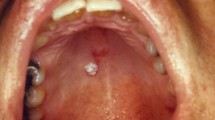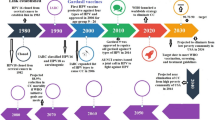Abstract
To investigate the expression of human papillomavirus type 16 (HPV-16) E5 protein in squamous neoplastic changes in the uterine cervix, the specific E5 antibody was generated and used to identify the expression of E5 protein in 40 cases of HPV-16-positive tissues and 5 previously identified HPV-negative normal cervical tissues. The results revealed that E5 protein was primarily expressed in the lower third of the epithelium in low-grade squamous intraepithelial lesions (SILs) and throughout the whole epithelium in high-grade SILs. In invasive squamous carcinoma, 60% of HPV-16-infected cancers which contained the episomal viral genome had the E5 gene, and could express E5 protein which was located throughout the whole epithelium. Previously, we documented the expression of type I growth factor receptors [ERBB1/EGFR (epidermal growth factor receptor), ERBB2, ERBB3 and ERBB4] in the full range of cervical neoplasias by immunohistochemistry assay. Hence, in this study, we extensively analyzed the correlation between the expression of E5 protein and the expression of type I growth factor receptors. Among 40 HPV-16-infected cervical neoplasias, we found that the expression of E5 protein was significantly correlated with either the expression of the ERBB1 or the ERBB4 receptor.
Similar content being viewed by others
References
Carraway KL, Cantley LC. A neu acquaintance for erbB3 and erbB4: A role for receptor heterodimerization in growth signaling. Cell 78:5–8;1994.
Chang JL, Tsao YP, Liu DW, Han CP, Lee WH, Chen SL. The expression of type I growth factor receptors in the squamous neoplastic changes of uterine cervix. Gynecol Oncol 72:62–71;1999.
Chen SL, Han CP, Tsao YP, Lee JW, Yin CS. Identification and typing of human papillomavirus in cervical cancers in Taiwan. Cancer 72:1939–1945;1993.
Chen SL, Hsieh TB, Tsao YP, Han CP, Yang YF. The coincidental expression of E5a and c-jun in HPV-6/11 infected condylomata. J Gen Virol 77:1145–1149;1996.
Chen SL, Huang CH, Tsai TC, Lu KY, Tsao YP. The regulation mechanism of c-jun and junB by human papillomavirus type 16 E5 oncoprotein. Arch Virol 141:791–800;1996.
Chen SL, Lin YK, Li LY, Tsao YP, Lo HY, Wang WB, Tsai TC. E5 proteins of HPV-11 and HPV-16 transactivate the c-fos promoter through NF1 binding element. J Virol 70:8558–8563;1996.
Choo KB, Pan CC, Liu MS, Ng HT, Chen CP, Lee YN, Chao CF, Meng CL, Yeh MY, Han SH. Presence of episomal and integrated human papillomavirus DNA sequences in cervical carcinoma. J Med Virol 21:101–107;1987.
Choo KB, Cheung WF, Liew LN, Lee HH, Han SH. Presence of catenated human papillomavirus type 16 episomes in a cervical carcinoma cell line. J Virol 63:782–789;1989.
Conrad M, Bubb VJ, Schlegel R. The human papillomavirus type 6 and 16 E5 proteins are membrane-associated proteins which associate with the 16-kilodalton pore-forming protein. J Virol 67:6170–6178;1993.
Crusius K, Auvinen E, Alonso A. Enhancement of EGF- and PMA-mediated MAP kinase activation in cells expressing the human papillomavirus type 16 E5 protein. Oncogene 15:1437–1444;1997.
Crusius K, Kaszkin M, Kinzel V, Alonso A. The human papillomavirus type 16 E5 protein modulates phospholipase C-gamma-1 activity and phosphatidyl inositol turnover in mouse fibroblasts. Oncogene 18:6714–6718;1999.
Cullen AP, Reid R, Campion M, Lorincz AT. Analysis of the physical state of different human papillomavirus DNAs in intraepithelial and invasive cervical neoplasm. J Virol 65:606–612;1991.
Durst M, Kleinheinz A, Hotz M, Gissmann L. The physical state of human papillomavirus type 16 DNA in benign and malignant genital tumors. J Gen Virol 66:1515–1522;1985.
Howley PM. Role of the human papillomaviruses in human cancer. Cancer Res (Suppl) 51:5019s-5022s;1991.
Hwang ES, Nottoli T, DiMaio D. The HPV-16 E5 protein: Expression, detection, and stable complex formation with transmembrane proteins in COS cells. Virology 211:227–233;1995.
Kell B, Jewers RJ, Cason J, Parkarian F, Kaye JN, Best JM. Detection of E5 oncoprotein in human papillomavirus type 16-positive cervical scrapes using antibodies raised to synthetic peptides. J Gen Virol 75:2451–2456;1994.
Lehn H, Villa LL, Marziona F, Hilgarth M, Hillemans HG, Sauer G. Physical state and biological activitiy of human papillomavirus genomes in precancerous lesion of the female genital tract. J Gen Virol 69:187–196;1988.
Leechanachai P, Banks L, Moreau F, Matlashewski G. The E5 gene from human papillomavirus type 16 is an oncogene which enhances growth factor-mediated signal transduction to the nucleus. Oncogene 7:19–25;1992.
Leptak C, Ramon Y, Cajal S, Kulke R, Horwitz BH, Riese DJ 2nd, Dotto GP, DiMaio D. Tumorigenic transformation of murine keratinocytes by the E5 genes of bovine papillomavirus type 1 and human papillomavirus type 16. J Virol 65:7078–7083;1991.
Matsukura T, Koi S, Sugase M. Both episomal and integrated forms of human papillomavirus type 16 are involved in invasive cervical cancers. Virology 172:63–72;1989.
Oelze I, Kartenbeck J, Crusius K, Alonso A. Human papillomavirus type 16 E5 protein affects cell-cell communication in an epithelial cell line. J Virol 69:4489–4494;1995.
Pecoraro G, Lee M, Morgan D, Defendi V. Evolution of in vitro transformation and tumorigenesis of HPV16 and HPV18 immortalized primary cervical epithelial cells. Am J Pathol 138:1–8;1991.
Pim D, Collins M, Banks L. Human papillomavirus type 16 E5 gene stimulates the transforming activity of the epidermal growth factor receptor. Oncogene 7:27–32;1992.
Pirami L, Giache A, Becciolini A. Analysis of HPV 16, 18, 31, and 35 DNA in pre-invasive and invasive lesions of the uterine cervix. J Clin Pathol 50:600–604;1997.
Reagan JW, Harmonic MS, Went WB. Analytical study of the cells in cervical squamous cell cancer. Lab Invest 6:241–250;1957.
Stoler MH, Rhodes CR, Whitbeck A, Wolinsky SM, Chow LT, Broker TR. Human papillomavirus type 16 and 18 gene expression in cervical neoplasias. Hum Pathol 23:117–128;1992.
Stoppler MC, Straight SW, Tsao G, Schlegel R, Maccance DJ. The E5 gene of HPV-16 enhances keratinocytes immortalization by full-length DNA. Virology 223:251–254;1996.
Straight SM, Hinkle PM, Jewers RJ, McCance DJ. The E5 oncoprotein of human papillomavirus type 16 transforms fibroblasts and effects the downregulation of the epidermal growth factor receptor in keratinocytes. J Virol 67:4521–4532;1993.
Tsao YP, Lee LY, Tsai TC, Chen SL. Human papillomavirus type 11 and 16 E5 represses p21 WafI/SdiI/CipI gene expression in fibroblasts and keratinocytes. J Virol 70:7535–7539;1996.
Yang YF, Tsao YP, Yin CS, Chen SL, Chu TY. Overexpression of the proto-oncogene c-jun in association with low-risk type specific human papillomavirus infection in condyloma acuminata. J Med Virol 48:302–307;1996.
Zhang K, Sun J, Liu N, Wen D, Chang D, Thomason A, Yoshinaga SK. Transformation of NIH 3T3 cells by HER3 or HER4 receptors requires the presence of HER1 or HER2. J Biol Chem 271:3884–3890;1996.
zur Hausen H, de Villiers EM. Human papillomaviruses. Annu Rev Microbiol 48:427–447;1994.
Author information
Authors and Affiliations
Rights and permissions
About this article
Cite this article
Chang, J.L., Tsao, Y.P., Liu, D.W. et al. The expression of HPV-16 E5 protein in squamous neoplastic changes in the uterine cervix. J Biomed Sci 8, 206–213 (2001). https://doi.org/10.1007/BF02256414
Received:
Accepted:
Issue Date:
DOI: https://doi.org/10.1007/BF02256414




